Modern Farmhouse Bathroom – Perfectly Imperfect Charm
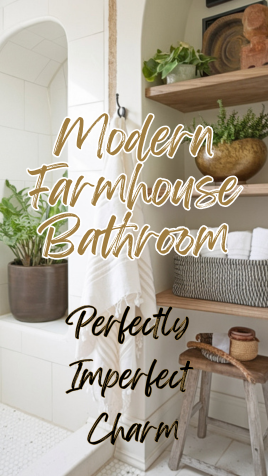
Rough Around the Edges – The Modern Farmhouse Bathroom – Perfectly Imperfect Charm
A modern farmhouse bathroom blends clean, contemporary design with authentic rustic elements to create a space that feels both fresh and inviting. It often features neutral colors, natural materials like wood and stone, and simple yet functional fixtures that highlight craftsmanship without overwhelming the room. The key to a successful modern farmhouse bathroom is balancing rustic charm with modern convenience, ensuring the space is as practical as it is stylish.
Farmhouse bathrooms typically include details such as shiplap walls, vintage-inspired tile, and reclaimed wood vanities paired with sleek hardware and minimalist decor. This combination creates a timeless look that can elevate any home while maintaining warmth and character. Modern farmhouse bathroom design is flexible, allowing for personalization through elements like apron-front sinks, vessel basins, and carefully chosen textures.
By incorporating thoughtful farmhouse bathroom ideas that focus on authenticity and subtlety, homeowners can achieve a bathroom that honors tradition without feeling outdated. This style appeals to those who want a calm, comforting space that also meets modern lifestyle needs.
The Elements of Beautiful Imperfection
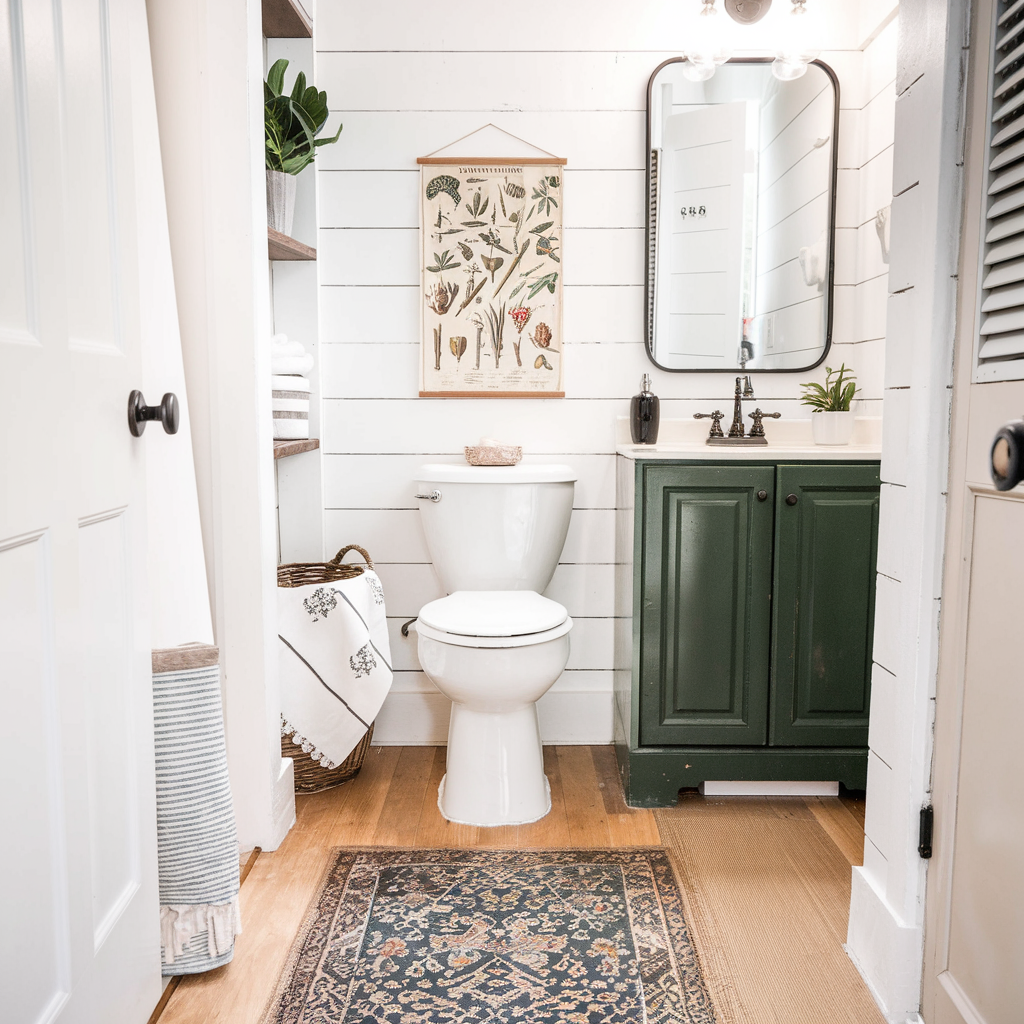
A modern farmhouse bathroom balances clean design with natural character. Its appeal lies in materials and finishes that show subtle irregularities, giving warmth and depth without feeling cluttered or outdated.
Why Perfect Spaces Feel Cold And Uninviting
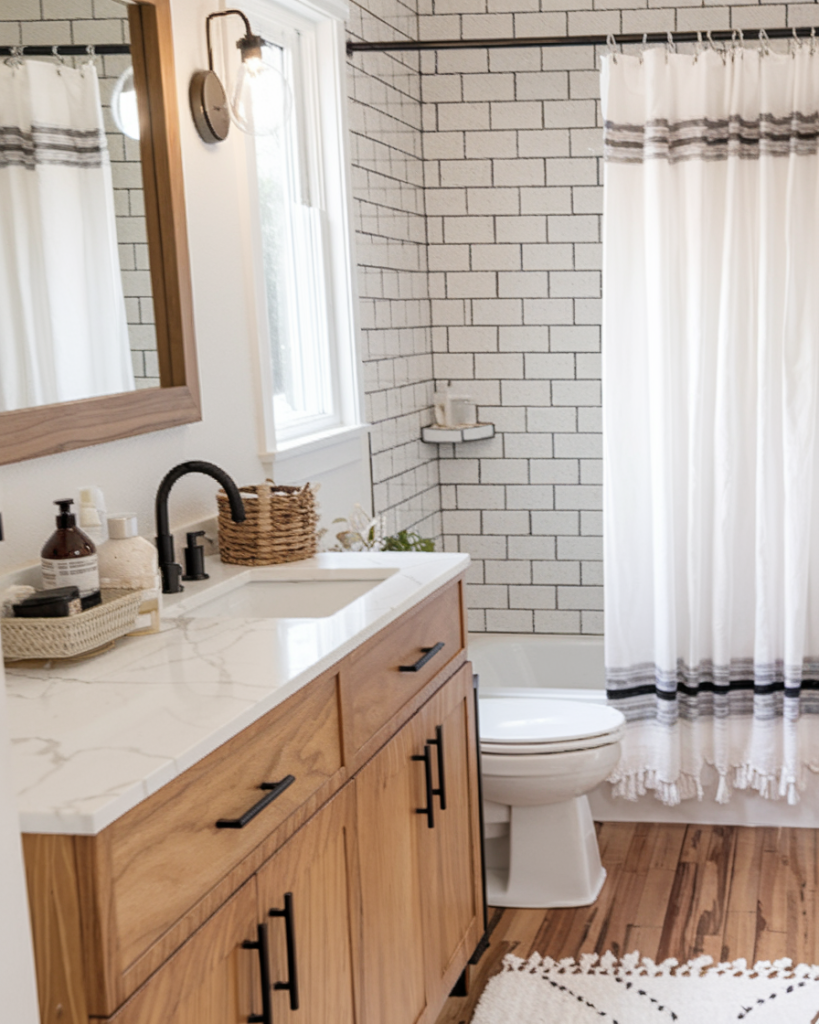
Spaces designed for flawless symmetry and uniformity often lack personality. Absolute perfection can feel sterile because it removes the marks of human presence and time. In bathrooms, overly sleek surfaces, like seamless white subway tiles with no variation, sometimes fail to convey comfort.
A room with no texture or variance can feel more like a showroom than a lived-in space. Imperfect surfaces, including natural wood and textured tiles, add layers that invite tactile and visual engagement. This approach makes the bathroom feel more welcoming and relaxed.
The Psychological Comfort Of Imperfection
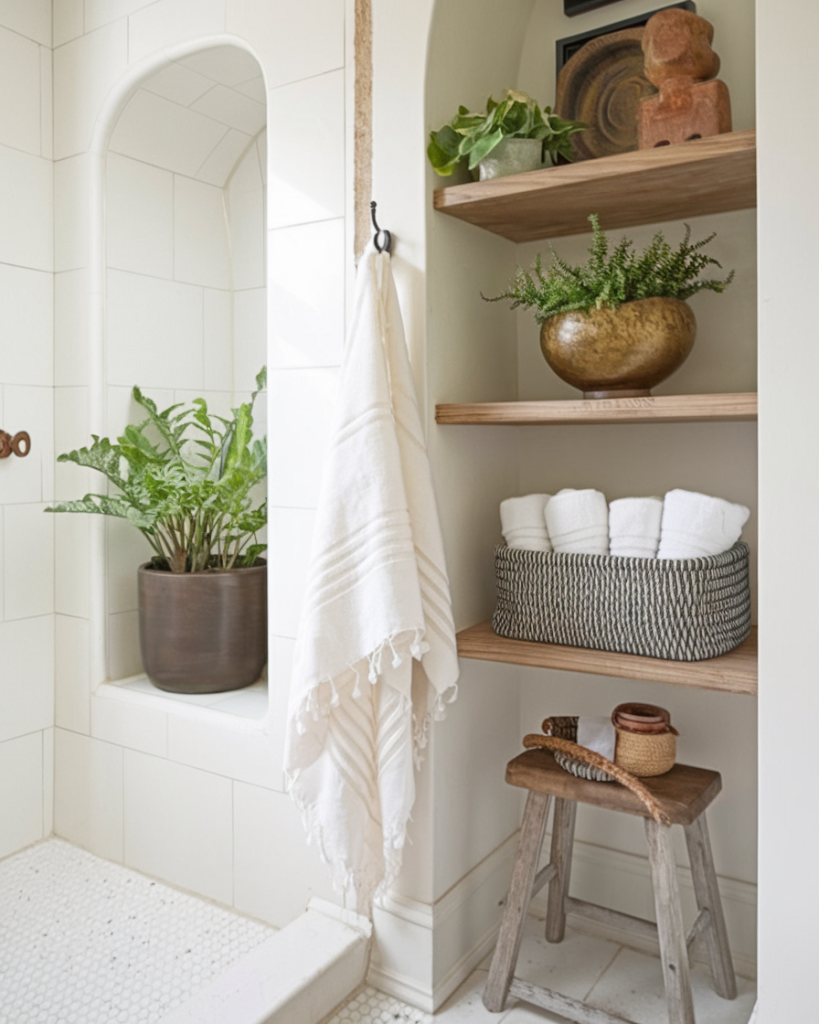
Humans naturally gravitate toward environments that show authenticity. Slight inconsistencies in materials trigger a subconscious sense of craftsmanship and history. These elements evoke calmness because they connect people to the natural world and to tradition.
For example, slight roughness in shiplap walls or the uneven edges of handmade tiles suggest the human hand at work. This fosters a comforting, less clinical atmosphere. The intentional presence of imperfection supports mental well-being by encouraging relaxation and a feeling of safety.
Modern Farmhouse As Rebellion Against Sterile Design
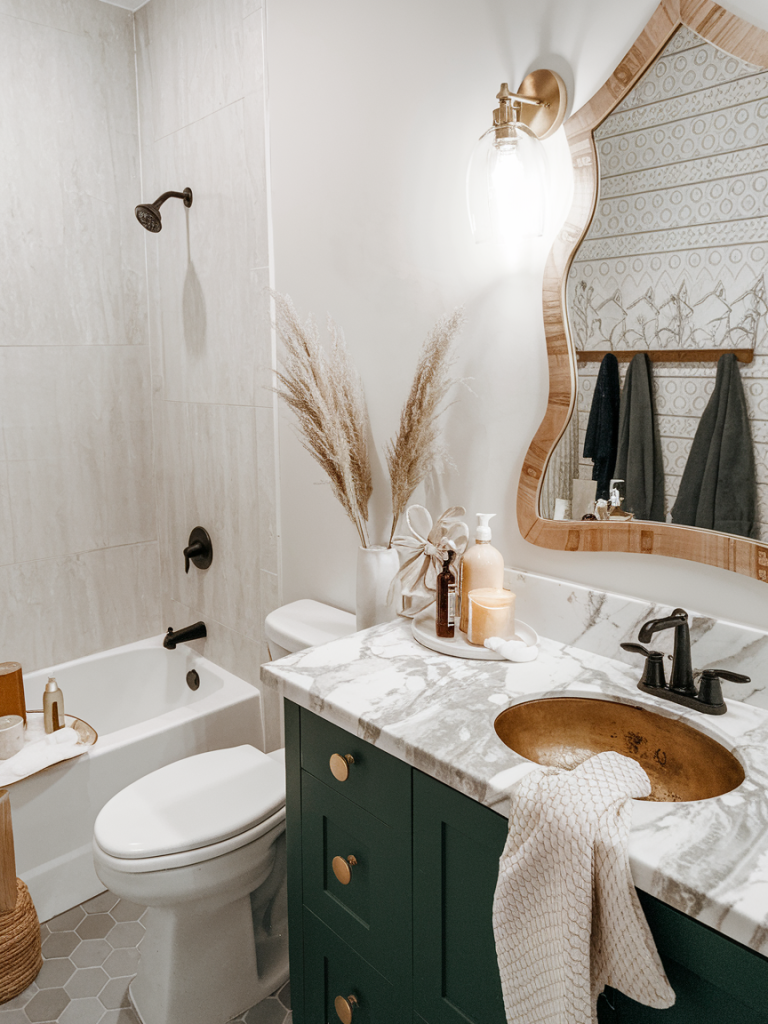
Modern farmhouse style intentionally rejects overly minimalistic or ultra-modern sterile bathrooms. It blends traditional farmhouse materials like wood finishes and vintage-style fixtures with modern clean lines.
This design is a quiet protest against cold, impersonal spaces. It prioritizes warmth and usability while maintaining elegant simplicity. The chosen materials—such as weathered wood contrasted with crisp white subway tiles—demonstrate a balance between old and new, function and aesthetic.
Weathered Wood With Natural Knots And Grain Variations
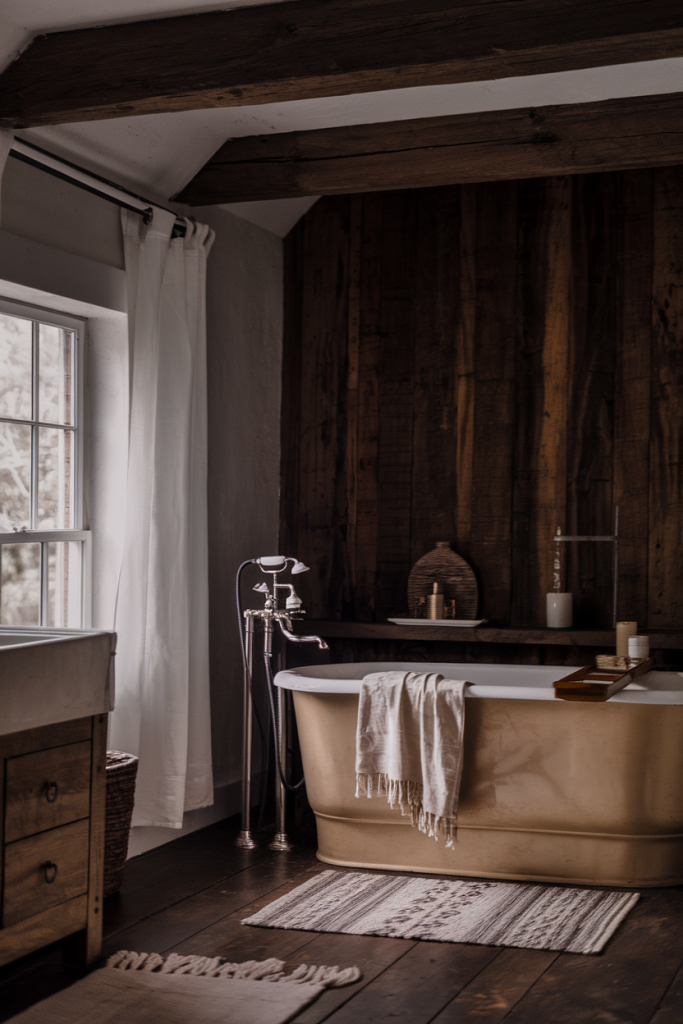
Weathered wood is a signature in modern farmhouse bathrooms. It shows irregularities such as knots, color shifts, and grain patterns, which add depth to spaces often dominated by smooth surfaces.
Using reclaimed or distressed wood for vanities or shelving introduces character while resisting the high gloss of pure modern finishes. These boards contrast nicely with the clean, shiny look of white subway tiles, creating a natural conversation between surfaces.
Wood finishes in this style are not smooth or uniform but intentionally preserve imperfections to make the area feel lived-in and authentic.
Hand-Forged Hardware With Slight Irregularities
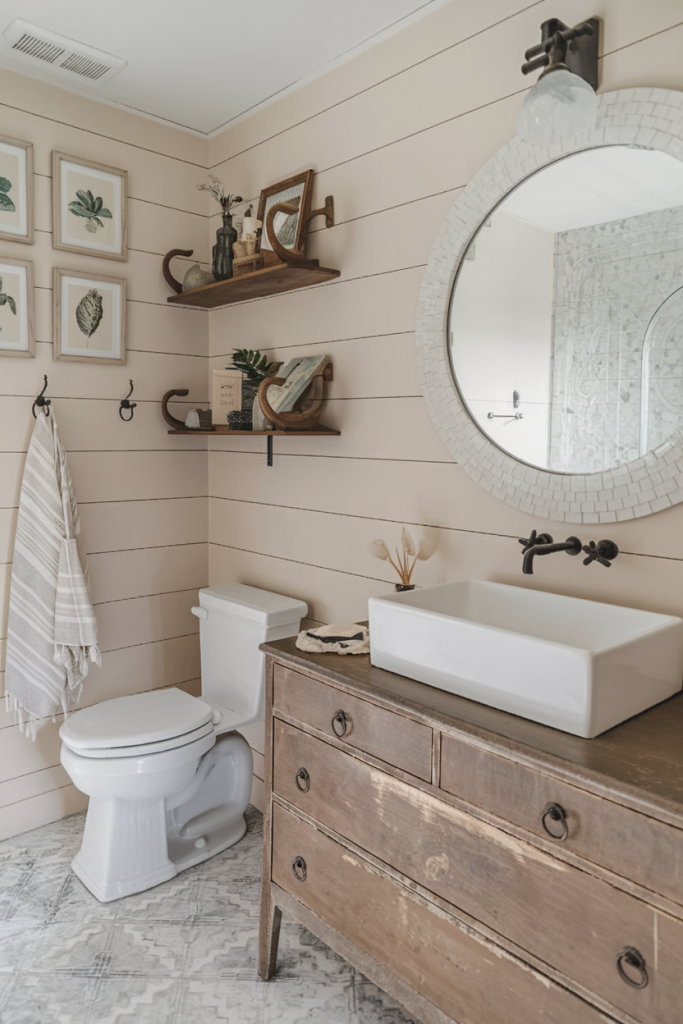
Hardware like drawer pulls, faucets, and hooks made from hand-forged metal presents small irregularities in shape and finish. These nuances make each piece unique, enriching the visual texture of the bathroom.
Brass or black matte metals with subtle hammer marks or uneven contours lend an artisanal quality. This is especially effective when paired with modern fixtures because it grounds the look in tradition while maintaining contemporary function.
Choosing hand-forged hardware signals attention to detail and a preference for craftsmanship over mass production.
Vintage Mirrors With Authentic Foxing And Patina
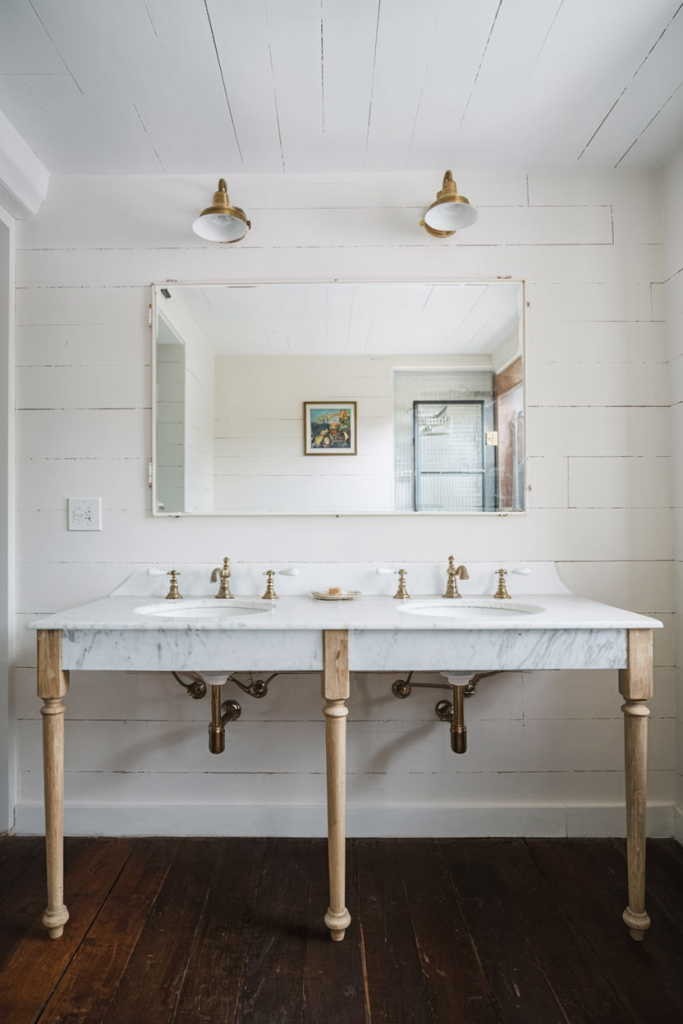
Vintage mirrors often feature signs of aging like foxing (small spots of oxidation) and patina on the frame or glass. These imperfections contribute to the overall warmth of the modern farmhouse bathroom.
Using such mirrors adds a layer of history and storytelling. Instead of pristine, factory-made glass, these mirrors offer subtle visual complexity and soften reflection with their aged surfaces.
They work well against crisp shiplap walls or simple white subway tiles, preventing the bathroom from feeling too new or overly designed.
Handmade Tiles With Subtle Color Shifts And Texture
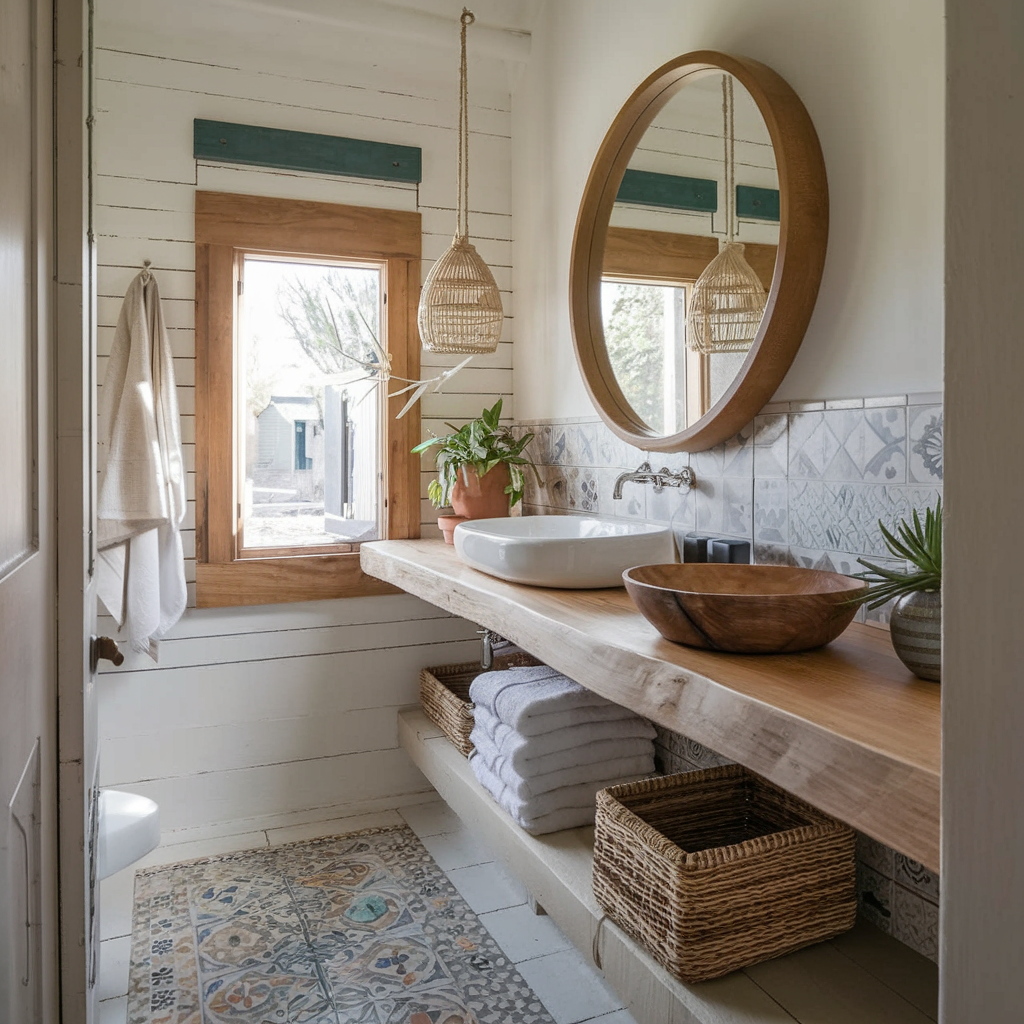
Handmade tiles bring unique variations in color and texture that manufactured tiles cannot replicate. These tiles often have uneven edges or slightly differing shades within the same batch.
Such subtle irregularities create a mosaic effect that enlivens surfaces, particularly floors or backsplashes. When installed next to the uniformity of standard white subway tiles, the difference highlights the beauty of imperfection.
The textured surface also adds tactile interest underfoot or at eye level, supporting the modern farmhouse goal of combining practical function with natural appeal.
Crafting Your Own “Aged” Story
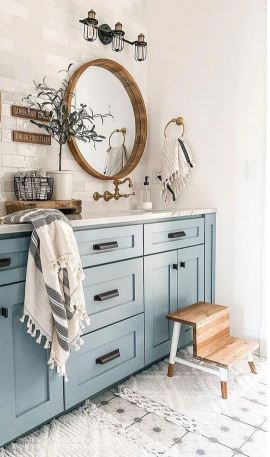
Creating an authentic aged look in a modern farmhouse bathroom involves careful selection and treatment of materials. Combining genuine vintage items with new materials distressed authentically can enhance charm without overwhelming the contemporary balance. Strategic wear patterns and thoughtful sourcing bring these elements together into a cohesive design.
Techniques For Distressing New Materials Authentically
Distressing new wood or furniture adds character by simulating natural aging. Common methods include sanding edges to expose raw wood, using a wire brush to create texture, and applying diluted paint or stain in layers to imitate weathering.
A combination of these techniques creates variation and realism. For example, slight chipping on corners or faded surfaces mimics years of use.
Repurposed furniture benefits greatly from these methods. Adding wear to drawer fronts or cabinet edges blends new pieces seamlessly with antique mirrors or woven storage baskets.
Using finishes like matte or chalk paint also supports the farmhouse aesthetic, providing an aged but maintained look.
Where To Find Genuinely Vintage Pieces Vs. Reproductions
Vintage elements like antique mirrors or wicker baskets add authenticity not easily replicated. Sources include estate sales, flea markets, and specialized dealers. Items with minor imperfections, uneven patina, or signs of long use usually indicate genuine vintage pieces.
Reproductions, while more affordable and consistent, lack subtle irregularities. They work well for woven storage baskets or bathroom vanities where durability is key but should be balanced with true vintage finds.
Catalogs and online marketplaces can offer both, so evaluating photos closely for wear, craftsmanship, and materials will guide selection.
The Art Of Strategic Wear Patterns
Wear patterns should highlight natural contact points. For instance, cabinet edges, drawer fronts, and areas near sink fixtures typically develop the most wear.
Applying subtle wear to these specific spots enhances realism without overdoing it.
Using a combination of fine sanding, targeted staining, or light chipping lets wear appear intentional. This approach creates a lived-in yet curated feel.
Strategic wear also applies to accessories like repurposed wooden frames or wicker baskets, where handles or corners can show slight distress while the overall piece remains solid and intact.
The Psychology Behind The Appeal
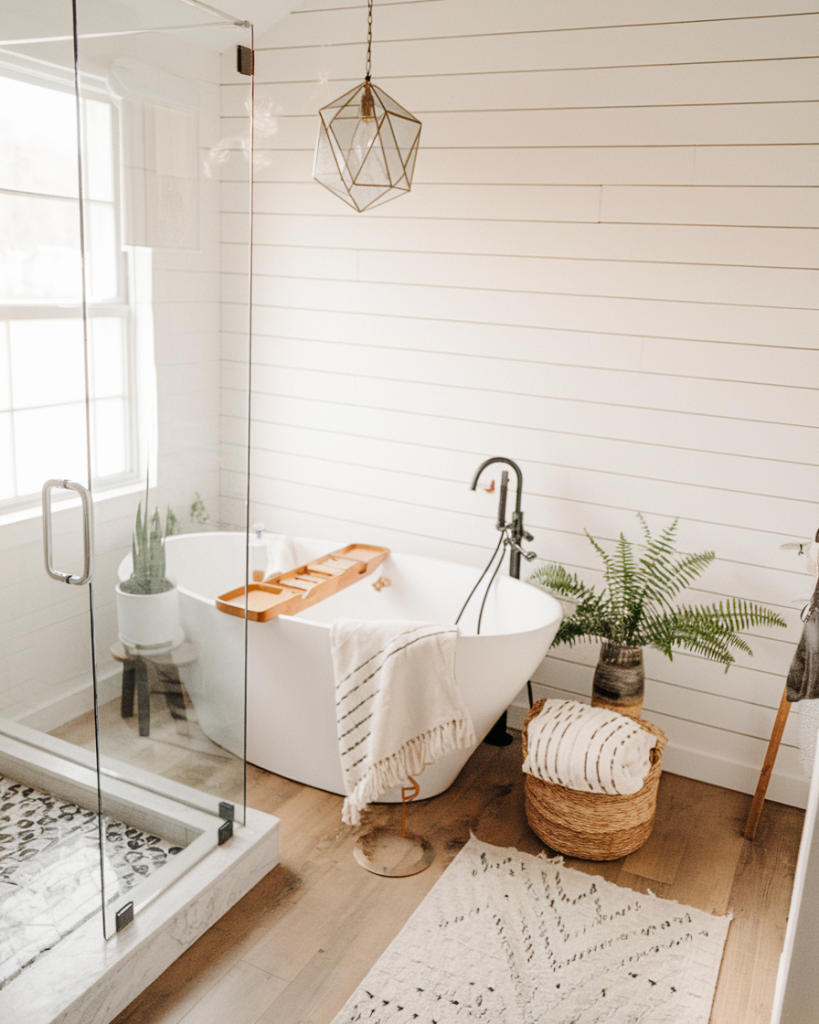
Modern farmhouse bathrooms balance simplicity and warmth through thoughtful design choices. This approach connects users with their environment by embracing natural textures, neutral colors, and functional beauty, making spaces feel inviting and authentic.
Why Imperfection Feels More Human
Imperfect elements such as hand-hewn wood, slightly uneven finishes, or vintage-inspired fixtures add character to modern farmhouse bathrooms. These small irregularities evoke craftsmanship and history, contrasting with overly polished surfaces common in contemporary designs.
This subtle imperfection encourages a sense of comfort and familiarity. It signals authenticity, reminding users that the space is lived-in and personal, not sterile. A neutral color palette often supports this effect by softening contrasts and aging marks, making wear feel natural rather than neglected.
Creating Spaces That Invite Touch And Interaction
Modern farmhouse bathrooms use materials and features that engage the senses. Textured walls, such as shiplap or beadboard, invite tactile interaction. Large mirrors reflect light and amplify the room’s openness, encouraging presence and awareness.
Window treatments in natural fabrics allow diffused light, enhancing connection with the outdoors while maintaining privacy. These elements combine function with warmth, making the bathroom a tactile sanctuary rather than just a utilitarian space.
The Japanese Concept Of Wabi-Sabi In Western Bathrooms
Wabi-sabi embraces impermanence and beauty found in simplicity and natural aging. In modern farmhouse bathrooms, this translates to choosing materials that show time’s passage gracefully, like weathered wood or matte black fixtures.
This philosophy aligns with the farmhouse aesthetic by highlighting beauty in subtle wear and natural flaws rather than perfect uniformity. Integrating wabi-sabi principles encourages mindfulness and acceptance in the space, supported visually by neutral tones and modest, elegant designs.
Balancing Act: Imperfect Aesthetics, Perfect Function
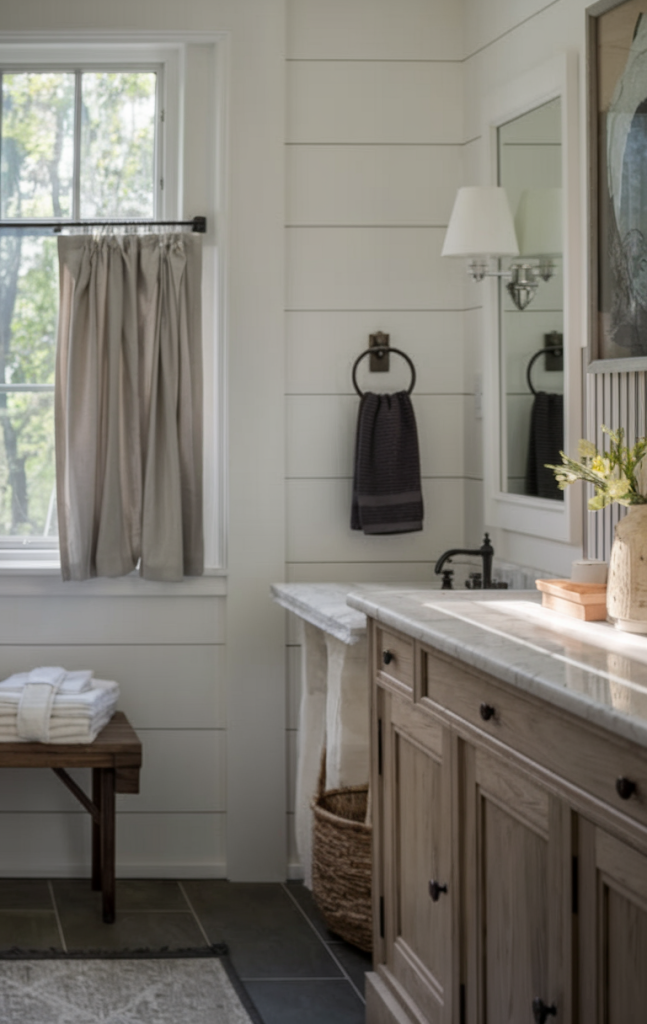
A modern farmhouse bathroom combines rustic charm with practical design. This balance means selecting weathered materials that maintain cleanliness, incorporating smart storage solutions that fit the style, and using plumbing fixtures that blend vintage looks with modern performance.
Ensuring Weathered Elements Don’t Compromise Hygiene
Weathered wood and distressed finishes are key to the farmhouse look but can harbor dirt if not properly treated. Using sealed wood or specially coated surfaces protects against moisture and bacterial buildup without losing the appearance of age.
Brushed or matte finishes on metals reduce fingerprint visibility while avoiding overly shiny, modern looks. Tile choices often include easy-to-clean subway tiles, which contrast natural textures with smooth, hygienic surfaces.
Open shelving and barn doors should be made from durable materials treated to withstand humidity. Proper ventilation and regular maintenance keep these elements both functional and visually authentic.
Smart Storage Hidden Behind Rustic Facades
Storage is essential in farmhouse bathrooms but should not disrupt the cozy aesthetic. Cabinets with distressed wood doors can conceal modern shelving systems, keeping essentials organized without clutter.
Sliding barn doors work well to hide storage areas, combining practicality with movable space-saving solutions. Open shelving made from reclaimed wood adds accessible storage while offering a platform for decorative baskets or linen stacks.
Using baskets, boxes, and labeled containers on open shelves maintains order and reduces visual noise. The goal is functional storage that supports daily routines while complementing the rustic design.
Modern Plumbing Disguised In Vintage-Style Fixtures
Farmhouse bathrooms often feature plumbing fixtures that appear vintage but perform to modern standards. Faucets and showerheads finished in matte black, brushed nickel, or antique brass combine old-world aesthetics with water efficiency.
Wall-mounted faucets or farmhouse sinks with apron fronts create visual authenticity while using modern materials that resist corrosion and staining. The plumbing behind the scenes is upgraded for durability and quiet operation but remains hidden.
Careful fixture selection ensures the bathroom operates smoothly while contributing to the overall rustic charm without sacrificing the convenience homeowners expect.
Imperfection Guide
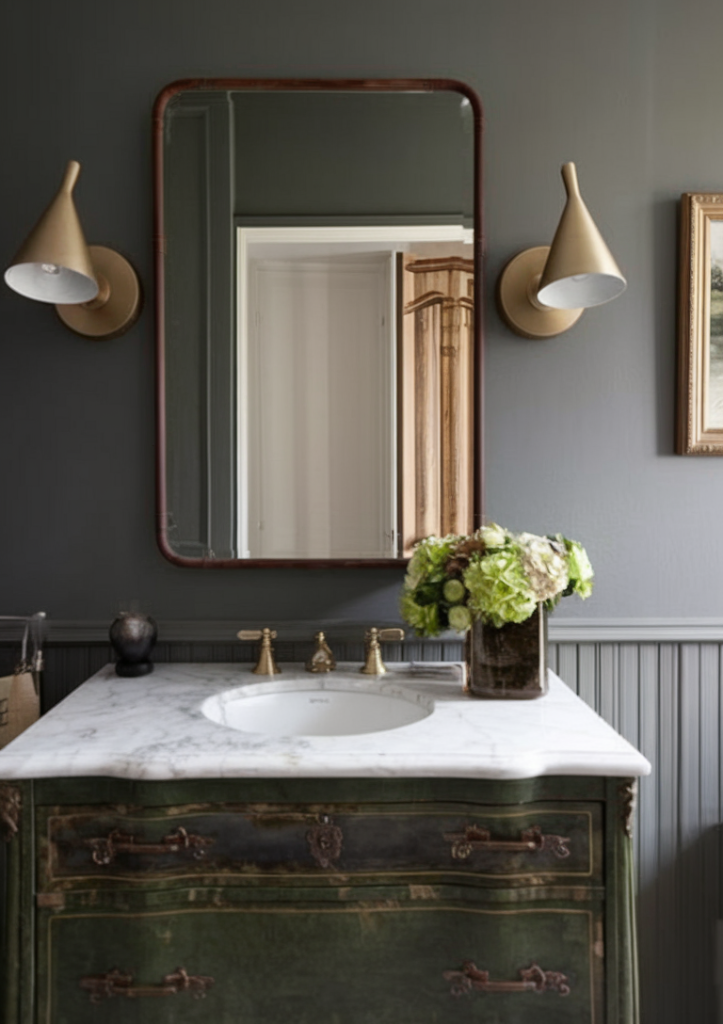
Embracing subtle imperfections enhances the authenticity of a modern farmhouse bathroom. These flaws provide character and warmth while maintaining clean, functional spaces. The key lies in balancing intentional wear and vintage detailing without sacrificing modern convenience.
Vanity Area Imperfections That Charm
A vanity with slight imperfections can serve as a focal point, especially when incorporating farmhouse elements. For example, a reclaimed wood vanity might show uneven paint or minor dents, which underscore its history and uniqueness.
Pedestal sinks and vessel sinks also contribute character when paired with distressed cabinetry or hardware exhibiting gentle patina. These elements highlight craftsmanship rather than uniformity.
Hardware showing minor scratches or mismatched pulls balances practicality with rustic appeal. Small chips in tile backsplash or subtle discolorations in grout fit the aesthetic when intentional and controlled, avoiding a neglected look.
Shower/Tub Weathering That Works
Clawfoot tubs are ideal candidates for subtle weathering, as minor surface marks or faded finish add vintage charm without undermining hygiene or comfort. A matte or slightly worn enamel coat on the tub enhances visual appeal by suggesting a storied past.
Natural stone or handmade tile in shower surrounds can feature irregular edges and color variations, imitating aging processes. Avoid overly polished, flawless materials to keep the rustic-modern connection intact.
Metal fixtures with a brushed or antique finish complement this look. Even slight water spots or mineral deposits around faucets can underscore authenticity if cleaned well enough to prevent buildup or damage.
Flooring That Tells A Story
Flooring provides an opportunity to showcase character through distressed wood or textured tile. Wide plank wood with knotty, uneven grain or softly worn edges fits naturally into the modern farmhouse style.
Porcelain or ceramic tile mimicking natural materials can have irregular glazes that simulate wear. Varied coloration, subtle chips, or matte surfaces contribute to a lived-in feel without compromising durability.
A simple table outlines flooring options:
| Flooring Type | Imperfection Allowed | Effect |
|---|---|---|
| Distressed Wood | Knotty grain, worn edges, minor dents | Warm, authentic farmhouse aesthetic |
| Textured Tile | Uneven glaze, slight color variation | Adds subtle character, practicality |
| Natural Stone | Irregular shapes, color variation | Enhances rustic elegance, timeless look |
Flooring imperfections should be deliberate to avoid looking battered. Proper installation and maintenance ensure longevity while preserving character.
